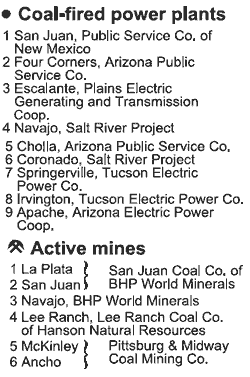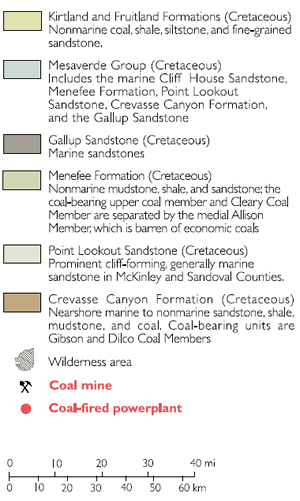
Frequently Asked Questions Related to Coal
Compiled by Shari Kelley and Gretchen Hoffman
- What is coal and how does it form?
- Which coal mines are currently active in the state of New Mexico?
- How do I contact mine operators for information?
- How do I find production data for coal in New Mexico?
- Which power plants in New Mexico are powered by coal?
- Where can I buy coal for personal use?
- What is humate and where is it produced?
- What is fly ash and how is it produced?
- Does the New Mexico Bureau of Geology and Mineral Resources maintain a coal database or library?
- Does the New Mexico Bureau of Geology and Mineral Resources regulate the coal industry?
- Does the New Mexico Bureau of Geology and Mineral Resources have facilities for determining the chemistry of coal?
- What is coal-bed methane and how is it produced?
- What is coal and how does it form?
-
Coal is a brownish-black to black combustible organic sedimentary rock formed by the decomposition of plant material in a poorly oxygenated setting, typically in a swampy or boggy depositional environment. As the organic material is buried, it is compacted and indurated over the course of millions of years, progressively passing through four main phases of coal development: lignite, sub-bituminous coal, bituminous coal, and anthracite The rank of coal is based on the amount of carbon and volatiles (water and gas) in the coal, as well as the energy content of the coal. Coal is composed primarily of carbon, hydrogen, oxygen, and some sulfur. Coal is a commonly used fossil fuel extracted from the ground either by underground mining, open-pit mining, or strip mining.
- Which coal mines are currently active in the state of New Mexico?
- As of Dec. 2004, the San Juan-underground, Navajo, McKinley, and Lee Ranch
mines are operating. All of these mines are in the San Juan Basin in the
northwestern part of the state (Figures 1 and 2). La Plata and the surface
operation of San Juan are no longer active and are in reclamation.




Mines, Mills, and Quarries in New Mexico provides the most up-to-date information about coal and other mines in New Mexico and is produced by the Bureau of Geology in cooperation with the New Mexico Energy, Minerals and Natural Resources Division. General information about the coal industry in New Mexico is in Chapter 3 of the 2002 Decision Maker's Field Conference Guidebook. - How do I contact mine operators for information?
- Obtain a copy of Mines, Mills, and Quarries in New Mexico to find current contact information.
- How do I find production data for coal in New Mexico?
- The New Mexico Energy, Minerals, and Natural Resources Department publishes production data annually in a booklet entitled New Mexico's Natural Resources. A paper copy of this document can be obtained free of charge in the publications office of the New Mexico Bureau of Geology and Mineral Resources. Coal production data are available from the Energy Information Administration, a branch of the U.S. Department of Energy.
- Which power plants in New Mexico are powered by coal?
- The three coal-fired plants in New Mexico are the San Juan generating station, operated by Public Service of New Mexico, the Four Corners generating station operated by Arizona Public Service, and the Escalante generating station, operated by Tri-State Generation & Transmission Association (see figures above). Coal from the San Juan mine supplies the San Juan generating station. Coal from the Navajo mine is used by the Four Corners generating station. The Lee Ranch mine supplies the Escalante station. For general information about the coal industry in New Mexico, see Chapter 3 of the 2002 Decision Maker's Field Conference Guidebook: Additional information about sources of electrical power for New Mexico is available from the Energy Information Administration.
- Where can I buy coal for personal use?
- The McKinley and Lee Ranch mines set aside some coal onsite to sell to individuals. Metallurgical coal, which can be used by blacksmiths, is no longer available in the state of New Mexico. The nearest source of metallurgical coal is the King Coal mine near Hesperus, Colorado (phone number (970) 385-4638).
- What is humate and where is it produced?
-
Humate is either weathered coal or organic-rich mudstone that is found in a coal-bearing sequence. Humate is primary used as a soil additive or as a drilling mud additive. The important factors in determining humate quality are the amounts of humic and fulvic acid. Several humate mines are located in the San Juan Basin.
The active humate mines can be found in the Active Mines spreadsheet available on the NM Energy, Minerals and Natural Resources Department web page: GIS, Maps, and Mine Data
- What is fly ash and how is it produced?
- Fly ash is a coal combustion byproduct of electrical generation. New Mexico coals can be quite high in ash content, so a significant amount of ash is left after burning coal at a power plant. This material can be used in concrete products, soil stabilization, and asphalt products. Not all fly ash is used and thus must be disposed of either at the power plant in disposal ponds or taken back to the mine and put in the pits. See the discussion and references regaring fly ash on the SEM- Pozzolan page. Also see the fly ash article in Chapter 3 of the 2002 Decision Maker's Field Conference Guidebook.
- Does the New Mexico Bureau of Geology and Mineral Resources maintain a coal database or library?
- Yes, the coal database, library, and other archival material are maintained by Gretchen Hoffman and Maureen Wilks.
- Does the New Mexico Bureau of Geology and Mineral Resources regulate the coal industry?
- No, our geologists evaluate coal resources and determine their economic potential. The New Mexico Energy, Minerals, and Natural Resources Department Mining and Minerals Division regulates the coal industry. See Chapter 3 of the 2002 Decision Maker's Field Conference Guidebook for an overview of the coal industry in New Mexico.
- Does the New Mexico Bureau of Geology and Mineral Resources have facilities for determining the chemistry of coal?
- No. The U.S. Geological Survey has facilities for analyzing the chemistry of coal; see their page discussing methods used in their laboratory. Commercial labs run analyses, as well (e.g., SGS North America Inc., Minerals Services Division).
- What is coal-bed methane and how is it produced?
- Information on coal-bed methane can be found in the Oil and Gas FAQ section.

